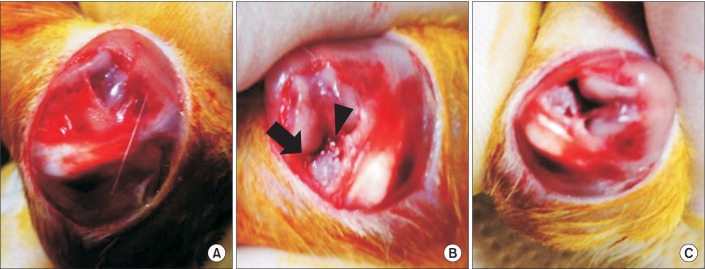1. Spector TD, Hart DJ, Byrne J, Harris PA, Dacre JE, Doyle DV. Definition of osteoarthritis of the knee for epidemiological studies. Ann Rheum Dis. 1993; 52:790–794. PMID:
8250610.

2. Little CB, Hunter DJ. Post-traumatic osteoarthritis: from mouse models to clinical trials. Nat Rev Rheumatol. 2013; 9:485–497. PMID:
23689231.

3. Poole R, Blake S, Buschmann M, Goldring S, Laverty S, Lockwood S, et al. Recommendations for the use of preclinical models in the study and treatment of osteoarthritis. Osteoarthritis Cartilage. 2010; 18 Suppl 3:S10–S16. PMID:
20864015.

4. Pickarski M, Hayami T, Zhuo Y, Duong LT. Molecular changes in articular cartilage and subchondral bone in the rat anterior cruciate ligament transection and meniscectomized models of osteoarthritis. BMC Musculoskelet Disord. 2011; 12:197. PMID:
21864409.

5. Sniekers YH, Weinans H, Bierma-Zeinstra SM, van Leeuwen JP, van Osch GJ. Animal models for osteoarthritis: the effect of ovariectomy and estrogen treatment. A systematic approach. Osteoarthritis Cartilage. 2008; 16:533–541. PMID:
18280756.
6. Zhang Y, McAlindon TE, Hannan MT, Chaisson CE, Klein R, Wilson PW, et al. Estrogen replacement therapy and worsening of radiographic knee osteoarthritis: the Framingham Study. Arthritis Rheum. 1998; 41:1867–1873. PMID:
9778229.

7. Turner AS, Athanasiou KA, Zhu CF, Alvis MR, Bryant HU. Biochemical effects of estrogen on articular cartilage in ovariectomized sheep. Osteoarthritis Cartilage. 1997; 5:63–69. PMID:
9010879.

8. Reis EM, Ropke J, Busanello A, Reckziegel P, Leal CQ, Wagner C, et al. Effect of Hypericum perforatum on different models of movement disorders in rats. Behav Pharmacol. 2013; 24:623–627. PMID:
23962987.

9. Fowler SC, Muma NA. Use of a force-sensing automated open field apparatus in a longitudinal study of multiple behavioral deficits in CAG140 Huntington's disease model mice. Behav Brain Res. 2015; 294:7–16. PMID:
26210937.

10. Nagase H, Kumakura S, Shimada K. Establishment of a novel objective and quantitative method to assess pain-related behavior in monosodium iodoacetate-induced osteoarthritis in rat knee. J Pharmacol Toxicol Methods. 2012; 65:29–36. PMID:
22037051.

11. Kuroki H, Nakagawa Y, Mori K, Ohba M, Suzuki T, Mizuno Y, et al. Acoustic stiffness and change in plug cartilage over time after autologous osteochondral grafting: correlation between ultrasound signal intensity and histological score in a rabbit model. Arthritis Res Ther. 2004; 6:R492–R504. PMID:
15535827.
12. Ostergaard K, Andersen CB, Petersen J, Bendtzen K, Salter DM. Validity of histopathological grading of articular cartilage from osteoarthritic knee joints. Ann Rheum Dis. 1999; 58:208–213. PMID:
10364898.

13. Pauli C, Whiteside R, Heras FL, Nesic D, Koziol J, Grogan SP, et al. Comparison of cartilage histopathology assessment systems on human knee joints at all stages of osteoarthritis development. Osteoarthritis Cartilage. 2012; 20:476–485. PMID:
22353747.

14. Chan WP, Lang P, Stevens MP, Sack K, Majumdar S, Stoller DW, et al. Osteoarthritis of the knee: comparison of radiography, CT, and MR imaging to assess extent and severity. AJR Am J Roentgenol. 1991; 157:799–806. PMID:
1892040.

15. Ferrandiz ML, Terencio MC, Carceller MC, Ruhí R, Dalmau P, Verges J, et al. Effects of BIS076 in a model of osteoarthritis induced by anterior cruciate ligament transection in ovariectomised rats. BMC Musculoskelet Disord. 2015; 16:92. PMID:
25903377.

16. Hart DA, Achari Y. Alterations to cell metabolism in connective tissues of the knee after ovariohysterectomy in a rabbit model: are there implications for the postmenopausal athlete. Br J Sports Med. 2010; 44:867–871. PMID:
19136500.

17. Yoshida A, Morihara T, Matsuda K, Sakamoto H, Arai Y, Kida Y, et al. Immunohistochemical analysis of the effects of estrogen on intraarticular neurogenic inflammation in a rat anterior cruciate ligament transection model of osteoarthritis. Connect Tissue Res. 2012; 53:197–206. PMID:
22141435.

18. Finkelstein JS, Brockwell SE, Mehta V, Greendale GA, Sowers MR, Ettinger B, et al. Bone mineral density changes during the menopause transition in a multiethnic cohort of women. J Clin Endocrinol Metab. 2008; 93:861–868. PMID:
18160467.

19. Lindsay R, Hart DM, Sweeney A, Coutts JR, Clarke A. Endogenous oestrogen and bone loss following oophorectomy. Calcif Tissue Res. 1977; 22 Suppl:213–216. PMID:
912525.

20. Martin-Millan M, Castaneda S. Estrogens, osteoarthritis and inflammation. Joint Bone Spine. 2013; 80:368–373. PMID:
23352515.

21. Im GI, Kim MK. The relationship between osteoarthritis and osteoporosis. J Bone Miner Metab. 2014; 32:101–109. PMID:
24196872.

22. Hannan MT, Anderson JJ, Zhang Y, Levy D, Felson DT. Bone mineral density and knee osteoarthritis in elderly men and women: the Framingham study. Arthritis Rheum. 1993; 36:1671–1680. PMID:
8250986.

23. Karvonen RL, Miller PR, Nelson DA, Granda JL, Fernandez-Madrid F. Periarticular osteoporosis in osteoarthritis of the knee. J Rheumatol. 1998; 25:2187–2194. PMID:
9818663.
24. Lee JY, Harvey WF, Price LL, Paulus JK, Dawson-Hughes B, McAlindon TE. Relationship of bone mineral density to progression of knee osteoarthritis. Arthritis Rheum. 2013; 65:1541–1546. PMID:
23494470.

25. Inada M, Matsumoto C, Miyaura C. Animal models for bone and joint disease: ovariectomized and orchidectomized animals. Clin Calcium. 2011; 21:164–170. PMID:
21289412.
26. Lei Z, Xiaoying Z, Xingguo L. Ovariectomy-associated changes in bone mineral density and bone marrow haematopoiesis in rats. Int J Exp Pathol. 2009; 90:512–519. PMID:
19765105.










 PDF
PDF ePub
ePub Citation
Citation Print
Print





 XML Download
XML Download